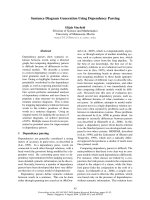Woodworking and mathematics
Bạn đang xem bản rút gọn của tài liệu. Xem và tải ngay bản đầy đủ của tài liệu tại đây (3.61 MB, 43 trang )
Woodworking and Mathematics
Table of Contents
Find exact width of cutting a board into N equal pieces .................... 2
Gear Math .................................................................................. 4
Compass Rose ............................................................................ 5
Rise and fall – degrees calculation ................................................. 7
Curved chest top ......................................................................... 9
Calculate Radius of Arc................................................................13
Compound Miters .......................................................................15
Taper Jig ...................................................................................16
Curved Deck Rail ........................................................................23
Bird Feeder................................................................................26
Pole Barn Angle Brace .................................................................29
Architect’s Ruler .........................................................................31
Golden Ratio ..............................................................................35
Divide a line into N equal segments ..............................................41
Introduction to Fractions .............................................................42
www.jsommer.com
Page 1
Woodworking and Mathematics
Find exact width of cutting a board into N equal
pieces
January 10, 2012 in Email Questions | Permalink
Question:
A friend asked me to help him cut a 10 ″ board into 10 equal parts factoring in for the loss due
to the 1/8″ blade kerf. We scratched our heads and wished we would have paid more attention
in math class.
We knew that we would have to make 9 cuts to get the 10 pieces. So 9 X 1/8″ = 1 1/8″.
So to approximate the cutting width we subtracted 1/8″ from each piece and cut the pieces
7/8″ inches wide. This was not exact but fairly close.
My question is what math formula should I use to get the exact width of cutting a board into
equal pieces factoring in the loss of the saw kerf? Thanks
A friend asked me to help him cut a 10 ″ board into 10 equal parts factoring in for the loss due
to the 1/8″ blade kerf. We scratched our heads and wished we would have paid more att ention
in math class.
We knew that we would have to make 9 cuts to get the 10 pieces. So 9 X 1/8″ = 1 1/8″.
So to approximate the cutting width we subtracted 1/8″ from each piece and cut the pieces
7/8″ inches wide. This was not exact but fairly close.
My question is what math formula should I use to get the exact width of cutting a board into
equal pieces factoring in the loss of the saw kerf? Thanks
Solution:
You logic will as you said get you pretty close to the correct cutting width.
Mathematically to calculate the cut width:
10*x + 9(1/8) = 10
10*x = 10 – 9/8 = 80/8 – 9/8 = 71/8
x = 71/80 which is very close to 7/8.
Many times in the wood shop a ruler is not the most accurate means of measurement unless our
measurements are to the nearest 8th or 16th.
In order to get a more accurate measurement of 71/80 see this diagram for details.
It shows how to mark on a piece of paper a length of 71/80 using standard ruler and the concept of similar
triangles from geometry.
www.jsommer.com
Page 2
Woodworking and Mathematics
See article Divide a line into N equal segments later in this document for a brief explanation.
This technique is used many times to divide a line into a given number of equal segments.
In this case by multiplying by 10 and dividing into 10 equal pieces we get an accurate length of a decimal
quantity.
www.jsommer.com
Page 3
Gear Math
Woodworking and Mathematics
June 30, 2010 in Uncategorized | Permalink
Here is a link to an article from Make Online Magazine with information about mathematics of
Gears.
/>
www.jsommer.com
Page 4
Woodworking and Mathematics
Compass Rose
October 23, 2009 in Email Questions | Permalink
Question:
John… I want to make a 36″ dia. compass rose with true north 8 points. I can’t find a plan
that gives me the angles. Do you know of any information that would be helpfull. I have been
doing woodworking for a while, I am 74 and keep active in my shop but decided to make
small projects and not furniture like I did. thanks Dan Lober
Solution:
Here is an image of an 8 pt compass rose. The angles are independent of the radius of the
circle.
8pt Compass Rose
www.jsommer.com
Page 5
Woodworking and Mathematics
Also for other number of points:
N
0
E
NbyE
11.25
EbyS
NNE
22.5
ESE
90 101.25 112.5
S
SbyW SSW
180 191.25 202.5
W
NEbyN
33.75
SEbyE
NE
45
SE
123.75 135
NEbyE
56.25
SEbyE
ENE
EbyN
67.5
78.75
SSE
SbyE
146.25 157.5 168.75
SWbyS SW SWbyW WSW WbyS
213.75 225
236.25 247.5 258.75
WbyN WNW NWbyW NW NWbyN NNW NbyW
270 281.25 292.5
303.75 315
326.25 337.5 348.75
Here is a link to some instructions on drawing a compass rose:
www.jsommer.com
Page 6
Woodworking and Mathematics
Rise and fall – degrees calculation
October 23, 2009 in Email Questions | Permalink
Question:
I don’t know if I’m saying this correctly and using the correct terms. I can’t find the answer,
and am having trouble figuring it out for myself. It seems like there should be a very simple
formula to calculate this.
I am building a ‘veranda’ for my tortoise, which will go over his dog house, from a 4′ x 8′
sheet of plywood and 2×4′s . I want it to be at an angle so that the rain will run off. So I
thought I would make it lower one inch for every 16 inches. Eight feet is 96 inches, and 16
goes into 96 six times, so one side will be 4′ tall and the other 3’6″ tall.
What I need is a formula that will take “rise and fall” (?) of X and Y (x=16, y=1) and convert it
to the degrees that I can set my table saw to so that I can cut the correct angle for the 2×4′s.
The resulting overall length won’t actually be 8′ because of the angling, so I don’t know if that
means anything, or needs to be taken into account, or what.
Attached and inserted is a diagram image.
Question Illustration
Thanks.
Bill
Solution:
To find the angle you need to use some trigonometry.
In your diagram we have a right triangle with a hypotenuse of 96″ (8 ft) an d an adjacent leg
of 4″ (difference between 4′ and 3′ 6″). Since you know the rise and fall is a ratio of 1 to 16
you can find the angle by computing the arc cosine of 1/16 using a calculator [this ratio is
what determines the angle, so if the length is not 8ft but you still want this slope for the over
hang then still use the 1 to 16 ratio].
www.jsommer.com
Page 7
Woodworking and Mathematics
For example, if you go to this site you
will find a basic right triangle calculator. Enter 16 for side c and 1 for side a (or could use 96
and 4) then click calculate and the site will return the angle you requested which in this case is
86.42 degrees.
If you cut a smaller board in the same ratio as your bigger project, such as 1″ tall and 16″
long in the form of the right triangle then you will have a template for the angle you need
without doing any mathematics. This is because of the mathematics’ property of similar
triangles which is the basis of trigonometry – the ratio of sides and angles are the same as
you make a triangle bigger and smaller using proportional increase or reduction in size.
This link to Wolfram-Alpha will
give you information on equations of the right triangle.
www.jsommer.com
Page 8
Woodworking and Mathematics
Curved chest top
October 23, 2009 in Email Questions, Uncategorized | Permalink
This question builds on the previous post which shows how to calculate the center of a circle
given a chord and distance from the chord to the circle (called the Saggita).
Question:
Hi,
i’m working on a wood chest and the lid i wanted it arched but i have no idea at what angle
and HOW MANY pieces of wood i need to complete the lid.
My chest lid BASE measure 27 inches and the height at the middle point it should be 7″…. the
stripes are about 1/2″ thick and 3″ wide. HOW do i do it?
PS: a small draft is attached to the message!
Thank you so much!
William!
www.jsommer.com
Page 9
Solution:
Woodworking and Mathematics
Here is a link to a GeoGebra simulation: />I created to illustrate how to answer the question.
Below is a picture from William with some additional lines I added to help to illustrate how the
mathematical solution does apply to his original question. Note – the height stated as 17″ is
incorrect, should be 7″. 17″ is more than half the length of the chord.
www.jsommer.com
Page 10
Woodworking and Mathematics
Here is a snapshot of a Google Spreadsheet I created to work out the calculations with his
specific information. Note D1 reference is for value of PI.
www.jsommer.com
Page 11
Chest Top Calculations
Woodworking and Mathematics
I also found a nice simple calculator for circle, arcs and chords which can also be helpful.
/>
www.jsommer.com
Page 12
Woodworking and Mathematics
Calculate Radius of Arc
March 26, 2008 in Reference, Uncategorized | Permalink
Many times you need to calculate the radius of a circular arc for a given chord width and
height (distance from chord to the top of the arc) – See diagram below:
On the diagram w represents the width of the circular arc (chord) and d is the height
(distance from chord to top of the arc). Given both of these we can calculate the radius of the
circle needed to create the arc from using the formula on the diagram designated as r.
Here is an example of a calculator to compute the radius:
Entries need to be same units
Chord Width (w) =
Arc Height (d) =
The formula is derived using Analytical Geometry. The chord and arc are drawn on the XY axis
with one end of the arc at point (0,0) and the other end at (w,0). The center of the arc will be
at point (w/2, d). Using the standard equation of the circle and algebra we can derive the
formula for the radius needed to create the arc. Below shows the derivation of the formula.
www.jsommer.com
Page 13
Woodworking and Mathematics
www.jsommer.com
Page 14
Woodworking and Mathematics
Compound Miters
August 20, 2007 in Reference, Uncategorized | Permalink
Compound miter cuts involve making a miter angle cut and a blade tilt cut for projects such as
crown molding, hexagon shaped container with
sides tilted out, etc. Some of these cuts require
not only a standard miter angle (angle 1 in
illustration) in a vertical direction but also a
horizontal angled cut called a bevel (angle 2).
I have found several very good sites which are
good resources with tools, explanations and
mathematics for compound miter cuts and
application.
This site has a Advanced Box Cutting calculator
to determine the proper cutting angles for
polygons
/>ed_Box_Cutter.html . And here is the page for
the mathematics of Dihedral and Equal Angle
Polygons (regular)
/>ihedral1.html .
A site with a calculator specific for a pyramid. />The same author also has good explanations, tables and a calcualtor for cutting crown molding
.
For additional information and instructions on Crown Molding see Alter Eagle site
.
This is a link to a Dr. Math article about Pyramid Construction
in which he includes some of the
mathematics and a good way to visual a compound angle and its mathematics.
www.jsommer.com
Page 15
Taper Jig
Woodworking and Mathematics
May 31, 2007 in Email Questions, Uncategorized | Permalink
Original Question:
I am constructing a taper jig to use with my ShopSmith woodworking machine. Is there an
already derived formula for conversion of taper (inches per foot) directly to degrees and vise
versa. I used the tangent of the opposite side (taper) divided by one foot (12 inches, adjacent
side of triangle) and then look up the degrees for the derived tangent for my right triangle.
This is the answer but I thought perhaps you already have a quick and easy formula for this.
Your help is appreciated. I really like your website. It has much useful information.
www.jsommer.com
Page 16
Answer:
Woodworking and Mathematics
This is an illustration of a typical taper jig used on a table saw.
The pictures below are pages describing the mathematics of a taper jig and suggestion how to
add a measuring device to set the jig taper directly in inches per foot.
www.jsommer.com
Page 17
Woodworking and Mathematics
Taper Jig
www.jsommer.com
Page 18
Woodworking and Mathematics
www.jsommer.com
Page 19
Woodworking and Mathematics
www.jsommer.com
Page 20
Woodworking and Mathematics
Reader’s response.
Thought you might like to see my completed Taper Jig (picture1, picture2). I used a 24 inch
long board next to the work instead of a 12 inches one, so my separation of the “V” is in 1/2
inch increments instead of quarters of an inch.
i.e. 1/4 inch per foot on 12 inches is same as 1/2 per foot on 24 inch length.
I used tangent to calculate the angles in degrees for each setting. My scale goes from 1/4 inch
per foot to 2 1/2 inches per foot and from 1.16 to 11.57 degrees. Note the taper in inches per
foot is the left column and the degrees are in the right column.
Again, thank you so much for your help. I think I was on the right track, just need a little
reassurance and coaching.
www.jsommer.com
Page 21
Woodworking and Mathematics
www.jsommer.com
Page 22
Woodworking and Mathematics
Curved Deck Rail
May 31, 2007 in Email Questions, Uncategorized | Permalink
Original Question:
My deck has a curve in it. It’s like a half circle, except its depth is not equal to its width. From
a bird’s eye view, the curve is 72″ wide and 48″ deep. The deck posts are already set.
There are posts at the point where the curve begins and ends and there are two additional
posts set at equal intervals, dissecting the curve into three parts.
To cut the top and bottom 3.5″ wide rails (2×4 lumber on the straight rail) I will use 2X6
lumber and draw a pattern to produce the three sections of curved railing.
To cut the rail cap (5.5″ wide, or a 2X6 on the straight rail cap) I will use a 2X 8 or 2X10 to
draw a pattern to produce the three sections of curved 5.5″ wide rail cap.
I can create the curve for the railing in two ways:
1. Transfer the curve of the facia board (that covers the deck framing’s joist ends) to the
deck rails?
2. Calculate the railing curve, as dictated by the post placement and curve dimensions.
Here is my question:
How do I do the easiest of the two methods?
Or, is there an easier way to calculate the rail curves so I can draw my patterns?
www.jsommer.com
Page 23
Answer:
Woodworking and Mathematics
Diagram of the representation of the curved deck railing:
Calculations:
GIVEN:
Width of curve of deck 72″
Depth of curve 48″
Width of rail 5.5″
LEGEND:
R = radius of deck curve. [37.5"]
a = angle of arc of 3 equal sections of deck rail. [70.8o]
V = added length for rail width
Z = length of cord of rail. [43.45" + 2* 9.04"]
W = minimum width of board needed to cut curve. [6.93" + width of the rail 5.5" ]
V = additional width to W (to draw pattern for curve) [6.75"]
www.jsommer.com
Page 24
Calculation Diagram
www.jsommer.com
Woodworking and Mathematics
Page 25









